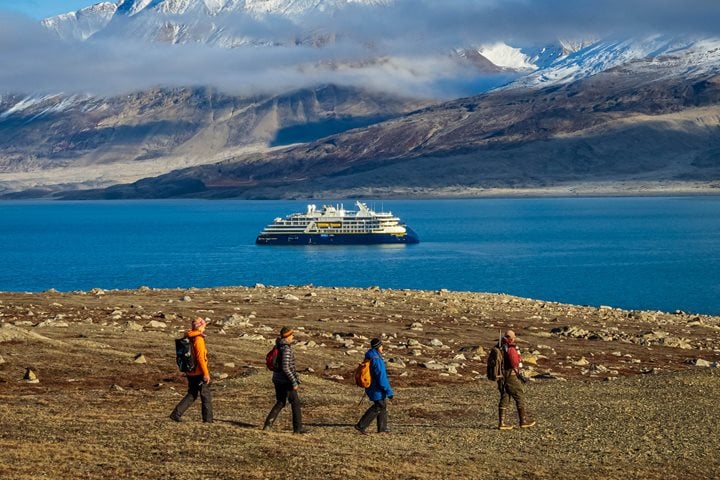The search for a route through the Arctic has long fascinated Ailsa Mainman. In 2014, she leapt at the chance to join the National Geographic Explorer as the onboard historian for one of Lindblad Expeditions’ very first Northwest Passage voyages. “Nothing I’d read quite prepared me for the experience,” Mainman recalls. “The sound of the ice moving beside the ship, the clarity of the air, and the truly awesome scenery will stay with me forever."
Seeing the legendary Arctic mirage—a distortion or inversion observed at high latitudes—gave Mainman a sense of how alien the landscape must have seemed to the early explorers who attempted to find the passage. “I found myself in awe of the challenges they faced in their wooden ships. To be able to explore the straits and the channels named by them and to see the islands and landmarks they charted was just incredible.”
Here, Mainman sheds more light on the significance of this northern waterway and what you can expect if you join our 22-day voyage, Northwest Passage: Greenland to Alaska.
What is the Northwest Passage? Where does it go?
The Northwest Passage is the sea route through an archipelago of islands which lie to the north of the North American mainland. This passage links the Atlantic and Pacific Oceans through landscapes of rocky terrain and tundra, against an awesome backdrop of mountains and glaciers.
Why was finding the Passage so important?
Silks and spices from the East were highly coveted and fetched enormous prices in medieval European markets. Until a passage was found, the only routes to China and the Indies were either slow overland journeys or long sea voyages. To reach the source of these prized goods, European ships had to either go east around the tip of Africa or take the westerly route around Cape Horn. Both voyages were hazardous and took many months. A nation that could find, and lay claim to, a quicker route through the Arctic would become wealthy and powerful indeed.
Who first found the Northwest Passage? Who were some other notable explorers who sailed it?
The quest to find a passage to Asia goes back centuries. Columbus himself (1492-3) had set out to reach the Indies when he ‘discovered’ America; while John Cabot (1497) was looking for a northern route when he stumbled upon the Grand Banks and a fortune in fish. Martin Frobisher (1539) reached as far as Baffin Island before being distracted by fool’s gold, and Henry Hudson (1610) was convinced that the Bay later named for him marked a way through to the Pacific. The great explorer James Cook (1776-8) came at it the other way and tried to find an entry from the west. All of them failed but many more attempts were made until, in 1845, the British Navy sent John Franklin to discover a route through. Two ships and 129 men famously perished in this attempt, and it was left to the Norwegian, Roald Amundsen, in the 45-ton sloop, Gjøa, to become the first European to successfully take a ship through the passage in 1903-6.
How long does it take to navigate the Passage?
These early expeditions used sailing ships and would equip themselves with supplies to last many months, fully expecting to overwinter in the harsh Arctic conditions. It is now established that there are five seasonably navigable routes–depending on ice conditions–through the archipelago of islands. The most frequently used route, which is approximately 900 miles long, runs east to west from north of Baffin Island to the Beaufort Sea. The first cargo ship to travel solo through the passage left Deception Bay, on Lancaster Sound, on September 19, 2014 and passed Point Barrow in Alaska just 11 days later. The Northwest Passage itinerary offered by Lindblad-National Geographic covers much more ground, starting in Greenland and finishing in the Yukon. Along the way the ship makes multiple stops and the entire voyage takes 22 days.
When can you sail the Northwest Passage? What time of year?
In winter, the northern oceans are choked with pack ice which makes these routes impassible. The ice breaks up and moves during spring and by summer there is sufficient clear water for ships to pass through. Some parts of the five sea routes are navigable as early as late May and some elements will stay open until October before temperatures fall and the ice closes in again. The summer months are, inevitably, the most reliable and the best time to explore.
What are some of the top exploration highlights in this storied region?
The Arctic is a majestic landscape. In summer, the tundra is a riot of low-growing plants which must flower and fruit in the short growing season. Glaciers which cloak the slopes of mountains retreat in the summer and spectacular icebergs are calved. It is a rugged terrain with ice and snow all year round at higher altitudes while offering spectacular hikes at lower levels. Visiting indigenous communities provides opportunities to learn about the skills needed to survive in the high Arctic and there are landings at sites where 19th century explorers came ashore, made winter camp, or buried their dead. Time spent in the ship’s chart room will help identify the islands, landmarks, and waterways which bear the names of those who came searching for the elusive passage.
What types of wildlife can be spotted in and around the Northwest Passage?
Polar bears are the iconic creatures of the Arctic. Males can grow to over 8 feet tall and weigh more than 1000 pounds. Their preferred prey are ringed seals, but they also hunt harp and bearded seals from the ice floes. The sight of large numbers of walruses hauled out on land or floating on moving pack ice is unique to the Arctic regions. Their remarkable tusks and stiff whiskers are used in their search for food on the ocean floor. Bowhead whales, together with narwhal and beluga whales have adapted to being under the ice by not having dorsal fins. The white belugas are easy to identify while narwhals, with their single twisted spear-like tooth, are known as the ‘unicorn’ of the sea. Blue whales, the largest of the species, as well as fin, sperm and humpback whales might all be spotted from the ship. Smaller marine mammals include minke whales, northern bottlenose whales and orca.
On land, look out for arctic foxes which turn from white to a greyish brown in summer and feast on seabird colonies, or chase the arctic voles and lemmings. Caribou can be seen grazing on sedges and grasses, building up fat to see them through the winter. Small herds of musk ox are occasionally glimpsed feeding on the dwarf willows along the edge of the coastal tundra.
Summer brings countless birds north to breed. Ducks and divers, geese and gulls all take advantage of this short season to rear their young. Above the seabird colonies, avian predators patrol the skies. The gyrfalcon is a truly Arctic species and was much prized by medieval noblemen. The skua’s main diet is lemmings, but it will also scavenge fish offal and snatch up chicks. The graceful arctic tern holds the record of the longest migration of any bird on the planet.
What is the weather like during the time of year ships can navigate the Passage?
Weather in the Arctic is unpredictable. Some days the warming land creates a sea fog which usually burns off by noon revealing clear blue skies. It can rain in summer, or even sleet, and the winds coming off the glaciers can be chilly. On other days the clarity of the light is extraordinary, and the strength of the sun calls for sunscreen and sunglasses. Bright sunlight reflecting off the snowy slopes is a truly remarkable sight. The night skies are bejeweled with millions of stars and, even in summer, there will be unforgettable displays of the aurora borealis.
What are the seas like in the Passage?
The changeable weather can whip up the surface of the sea, but the numerous islands provide shelter from huge swells and wherever there is pack ice the seas generally stay flat. Windless days bring a sense of great stillness and a magical calm. High winds accompany the rare Arctic storms and churn up the ocean causing sea ice to break up and move off in different directions. As the oceans warm, there is some evidence that storms will become more frequent but a voyage though the Northwest Passage is unlikely to produce the conditions experienced crossing the Drake Passage to reach Antarctica.





